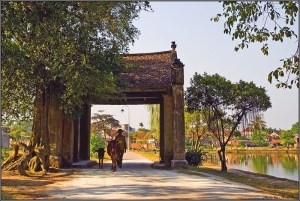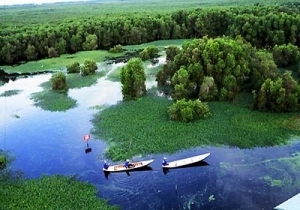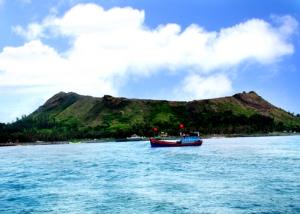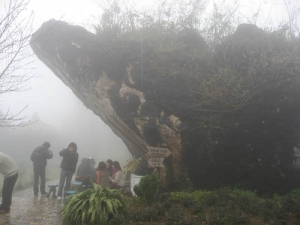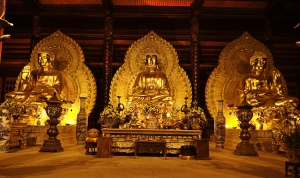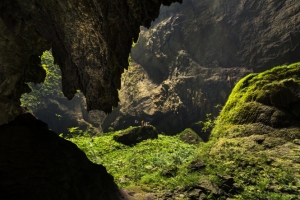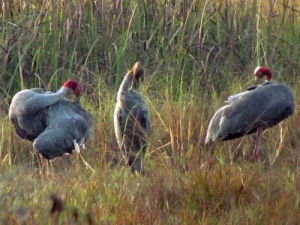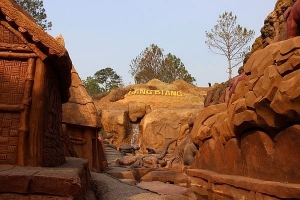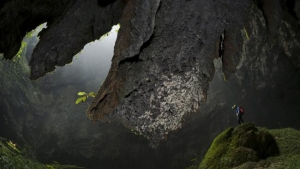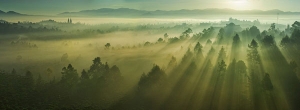
Asia Pacific Travel Team
Duong Lam ancient village in autumn
Only 50 km away from Hanoi, Duong Lam is an appropriate destination for tourists to have peaceful experiences within one day.
Duong Lam, located in Son Tay town, Hanoi is the ancient town with many houses dating back up from the 16th century. Despite the erosion of time, Duong Lam today still preserves the inherent charms with mossy tiled roofs and unique laterite walls, old wells and communal houses, taking visitors back to the beautiful past of Northern villages. Many houses had been built in a long time since 1649 by honeycomb rocks, iron woods, which have stood on solid foundations, in spite of high win and heavy rain. Visiting here, tourists will enjoy “reading” the traces of time marked in every corner, from the neck stamps on doors, the sophisticated glyphs to mossy partitions.

Surrounding the village is a system of ponds, creating romantic scenery. On sunny days, the pond system is the air conditioning of the village.
The unique features of these houses are being kept cool in summer and warm in winter, while the furniture is maintained originally.
Under the guidance of many people, autumn is the year’s best time to visit and feel remarkably the space of the ancient one, with pigs and chickens wandering about the village streets; rice being ready to harvest and dried straw pervading pastoral perfumes.
Not only walking and contemplating ancient beauties, people also are attractive to explore the traditional handicraft villages, the intangible cultural features, stories about two kings, Phung Hung and Ngo Quyen, as well as legendary of Sword hill and Silk lake.
Until now, Duong Lam has been trespassed by market and service factors. Sometimes, the happiness is simple, such as renting a bike, going around the village to discover and get away from the outside chaos and bustle.
The local people are quite hospitable, hence, it is not surprising if you are invited into a house to drink a cup of tea, have a meal and listen to the host thoroughly answer all your questions.
A trip to Ca Mau - The peaceful land
Every time setting foot in Ca Mau, my mind recalls lines of verse: My Fatherland as a ship, whose prow is Ca Mau Cape. The cape is in the southernmost of the country among the boundless waves, charming landscape and warm affection of local people.
The final milestone of the S-shape country is a must-see place for any traveler coming to this land. Ca Mau Cape features the national flag flying in the clear blue sky dotted with fluffy white clouds. Looking beyond the skyline, Vietnamese people can take pride in this land.

In Ca Mau Cape National Park, the vast mangrove forest with tree-trunks rises up to the sky, and fasciculate roots plant deep into the soil, interlacing with each other to create odd shapes. The yellowish green and white flowers embellish the dense green foliage. Deeper into the forest, the air gets cooler and cooler, the forest is in a perfectly pristine condition.
Following boats cleaving the waves, passing through the villages along the riverside, visitors can see bustling wharves where people gather for buying and selling. You can feel the breath of the sea with the strong smell of fish sauce and the salty taste in the sea breeze.
When the light of a new day starts, looming behind swathes of trees, the river is sparkling, and the forest wakes up suddenly to welcome the new lives of all creatures. At the end of a day when the sunset gradually fades away, families gather leaving behind a busy day.

It would be a pity when you come to Ca Mau but miss a chance to stay at local people’s houses. The homestay model has become familiar with many local families, therefore, visitors from the South to the North, or even Western tourists are no longer strangers to them. Tourists can come to the spacious houses to discover the daily life of countryside dwellers among rivers and water areas. They can take a rest on hammocks in the porch, watching straight lines of areca trees with yellowish flowers whose gentle perfume pervades the air after the afternoon shower.
The houses here are usually surrounded by canals full of large and small mangrove trees with tender buds and yellow flowers. On the canals, people can spread their nets or follow the boats to go fishing. In a panoramic view, the entire surface of the water is so quiet that even a falling leaf can cause ripples.

Dinner is served with hearty specialties of the watershed area, including fresh skates which have just been pulled out of the river, red fried shrimps and brown stems of water morning glory. The hosts also cook many kinds of seafood which they catch or buy from the neighborhood to serve guests. Besides thoi loi fish, or mudskipper, a specialty in seaport area, visitors will be treated with a variety of seafood such as oyster, razor shell and other special kinds of fish. The idle talks at the kitchen table are even livelier when there is no distance between hosts and guests.

Owners of the house are familiar with tourists. They treat the guests as their relatives. Everyone can freely move around, discovering everything, staying inside, lying in a hammock or going fishing.
The night was so quiet that I can even hear the sound of the insects and fish jumping in the canals. Before the sun came up, the host already prepares breakfast which is simple yet tasty. Leaving Ca Mau, my heart is still lingering with the feeling of belonging. The journey to this land brought me the feeling of coming back to my beloved family.
Ly Son - The land of garlic
But the island has more on offer for tourists, so Ly Son is emerging as a good destination for many visitors owing to its blue sea, while sand and yellow sunshine. Given numerous hearsays about the island, I decided to make a visit all on my own to Ly Son for relaxation.

It took me more than 20 hours to reach Quang Ngai City from HCMC on a sleeper coach. Then I took a bus running from the provincial city to Sa Ky Fishing Port at 6 a.m. and later it took me another 40 minutes to board a ship to visit the island.
There is only a daily trip to Ly Son Island by high-speed vessel or wooden ship. So, if one does not book tickets in advance or queue up to buy tickets early in the morning, they will have to wait until the next day.
June-September is the most wonderful period to go to Ly Son Island because of its golden sunlight and blue sea and sky. But those who want to witness how garlic is cultivated and harvested, the time between October and the year-end is ideal.
Despite the ocean waves, the high-speed vessel headed straight to the island, taking us to Ly Son in about one hour. The trip could take a longer time of 2.5 to 3 hours if travelling on a wooden ship.
Ly Son catches tourists’ eyes with its bustling and hustling port occupied by hundreds of both islanders and visitors. Islanders carry cargo of any kind on wooden ships from the mainland to the island. The port is always busy at the time between 9 a.m. to 10 a.m. with a lot of boats checking in and out.
Residents lead a peaceful and simple life on the island where hospitality and catering services are not well-developed. Lodgings are mostly located in the area surrounding the port with the Ly Son Hotel being the largest on the island. The room tariff at the hotel ranges from VND350,000 to VND400,000. However, one can choose to stay at locals’ homes at much lower prices of VND50,000-100,000 only for one person per night, or they can even set up a tent on the coast.

Farmers are harvesting garlic
Ly Son Island is quite small, covering a total area of 10 square kilometers but it is home to more than 20,000 inhabitants, mostly residing in An Vinh and An Hai communes on the big island. In fact, Ly Son is the name of the biggest island among a cluster of several islands. There are also about 1,000 people living in An Binh Commune located on another smaller island.

An Binh Island
Paying a visit to Ly Son between June and September, tourists will have a chance to enjoy local shallots and water melons. Shallots are planted virtually everywhere at the foot of Thoi Loi and Gieng Tien mountains. If ones reach the top of the mountains, they will have a chance to experience a panoramic view of green shallot beds that are looked after by a few farmers. Meanwhile, water melons there are not so big as ones in the mainland, but its flavor and tastes are said to be better.
Those traveling to the island during the final three months of the year will be able to enjoy the island’s renowned garlic and take part in the harvest of garlic with local farmers. Similar to shallots, garlic is grown on large areas with virtually every household having several garlic beds.
The total area under garlic cultivation is around 300 hectares, with an annual yield of 1,500 tons. The price of Ly Son-grown garlic is some VND100,000 a kilo, with the special garlic fetching up to VND1 million a kilo.

Despite its limited area, Ly Son is home to dozens of big and small historical and cultural relics such as Duc Pagoda, Hang Pagoda, To Vo Gate, Hoang Sa and Truong Sa army squadrons memorial, Am Linh Tu Temple and some ancient homes in Ly Son District. Especially, on climbing the winding and rugged road leading to the top of Thoi Loi Mountain, visitors can admire the vast sea with spectacular waves far away. The scenery of Ly Son is also beautified by various cliffs overlooking the sea, and several caves formed by the erosion of seawater.
Traveling to Ly Son, visitors can also taste a number of delicious dishes. In addition to signature garlic salad, there are urchin porridge, black sticky cake, and king crab, among others. Notably, visitors can participate in the Hoang Sa soldiers commemoration festival taking place in late February or early March of the lunar calendar.
Ham Rong Mount in the mist
The mount is not too high so it does not challenge human health. However, tourists should not go there alone to indulge into the loneliness and chill but it would be perfect to go with partners or friends.
Trang An Scenic Landscape Complex - A convergence of cultural and natural values
Being endowed with a beautiful landscape, Trang An Scenic Landscape Complex in Ninh Binh Province in Northern Viet Nam is called as an “Ha Long Bay on land” with numerous caves, mountains, valley, trees and historic relics.
On 23 June 2014, Trang An has just been inscribed in the UNESCO’s World Heritage List, proudly being the Viet Nam’s first site to be acknowledged as a mixed natural and cultural heritage.
Covering an area of 10,000ha in Hoa Lu, Gia Vien and Nho Quan districts and Ninh Binh City, Trang An Scenic Landscape Complex includes Trang An Eco-tourist Site, Tam Coc- Bich Dong Landscape and Hoa Lu Ancient Citadel.
With a spectacular landscape of limestone karst peaks permeated with valleys, some of which are submerged, and surrounded by steep, almost vertical cliffs, Trang An Eco-tourist Site is considered as an outdoor geological museum because it is entirely surrounded by bow shaped limestone mountain ranges lying on a delta wetland area.

According to current statistics, Trang An has 48 grottoes and caves alternating with 31 large and small valleys. Each valley is a various charming beauty bringing a multi-colorful picturesque landscape. Here is evaluated as an area of rare and unique natural beauty of the world with around 500 species of flora, 73 species of birds and 41 species of other animals, and is renowned for its diverse ecosystem, unique natural beauty and geological characteristics.
Bai Dinh - the largest pagoda in Viet Nam and Southeast Asia is located in Trang An eco-tourism site belonging to Gia Sinh commune, Gia Vien District. The pagoda is promising to be a Buddhist center of the region.
In addition to Trang An Eco-tourist Site, Tam Coc- Bich Dong Landscape and Hoa Lu Ancient Citadel are in core zone of the heritage site. Located in Ninh Hai Commune, Hoa Lu District, Tam Coc-Bich Dong still remains primary natural features with unique architectures alternating with pagodas and caves such as: Tam Coc, Thai Vi Temple, Bich Dong Pagoda, Tien Cave, Mua Cave...

Not only serving as a cradle of civilization of ancient Vietnamese, Trang An also used to house the old capital of the Vietnamese feudal and independent state, Hoa Lu Ancient Citadel, more than 1,000 years ago. Hoa Lu Ancient Citadel is a national relic related to the three dynasties in feudal history of Viet Nam (Dinh, Le and Ly dynasties in the 10th and 11th centuries). This area consists of defense earthen walls, palaces, temples and shrines which make magnificent fairy scenery. According to old historical books, in 968, after defeating twelve armies of rebels and unifying the country, Dinh Bo Linh came to the throne as King Dinh Tien Hoang. He set up the capital in Hoa Lu and named the country Dai Co Viet. From 968 to 1009, six kings of the Dinh, Le and Ly Dynasties set up the capital there. In 1010, King Ly Thai To moved the capital from Hoa Lu (Ninh Binh) to Thang Long (Ha Noi). Since then Hoa Lu has remained the ancient capital.
Trang An Scenic Landscape Complex is a very unique example of human history, not only for Viet Nam but also for the region. It has a combination of both natural and cultural values.
In 2013, Ninh Binh tourism welcomed more than 4.5 million arrivals with total tourism receipts of VND 900 billions. It is expected that the provincial tourism receipts will increase rapidly after the recognition as the world’s mixed natural and cultural heritage of Trang An Scenic Landscape Complex.
Pham Thanh
Vietnam through international visitors’ eyes
In the first half of this year, many Vietnamese tourism sites were cited by the international mass media as among the world’s best, serving as a source of pride and encouragement for those directly involved in the tourism industry.
Trip Advisor – the world’s premiere tourism website – selected Hanoi as one of top ten must-see travel destinations in 2014.
Ha Long Bay ranked fourth among the eight most beautiful sites in the world by Mymodernmet.com (the US) and was cited as one of 26 places that appeared to have arisen out of a fairy tale by the US-based website BuzzFeed.
.jpg)
HaLong bay
The UNESCO-recognised bay was also listed among the top eight green spaces/ national parks in Asia by Agoda.com, one of the continent’s leading hotel booking websites.
The New York Times ranked Quang Binh eighth among 52 ideal destinations for visitors in 2014 while the US-based Business Insider and the National Geographic (Russian language version) selected Quang Binh’s Son Doong as one of 12 most impressive caves and an adventure tour in the world in 2014.

Son Doong cave
The travel column of UK newspaper “The Telegraph” named Danang’s Ba Na cable car system on its list of ten amazing cable cars around the world.
Serene Hanoi, Holiday Diamond Hue and Essence Hanoi were among Trip Advisor's 25 best hotels worldwide.
Marriott Hanoi was awarded the Best New Hotel Construction and Design in the Asia-Pacific region at the 2014 International Property Awards.
Thua Thien-Hue was honored as an ASEAN City of Culture in the 2014-2015.
The UK magazine Rough Guides viewed Hoi An ancient town - a world cultural heritage site in the central province of Quang Nam - as one of the 20 most interesting places in the world to explore at night.
Nha Trang was chosen as one of the most ideal destinations for 2014 summer by a prestigious travel website Price of Travel.

Nha Trang
La Maison 1888 Restaurant at InterContinental Danang Sun Peninsula Resort reached the top four most beautiful restaurants in the world, according to New York Daily and the Daily Meal.
The selection testifies to the fact that Vietnam is an ideal tourist destination for foreign visitors.
In the first half of this year, Vietnam received more than 4.28 million foreign visitors (up 21% against the same period last year) and 23.4 million domestic holiday-makers (up 7%), grossing VND125 trillion in total revenue (up 22%).
A weekend in Lo Go - Xa Mat National Park
The national park encompasses Tan Lap, Tan Binh and Hoa Hiep communes in Tan Bien District, Tay Ninh Province, which is in between the Central Highlands, the southeast and the Mekong Delta. Covering about 19,000 hectares, the park is endowed with a variety of flora and fauna.

Along with the inlaid forest between deciduous forest on the lowland and evergreen forest along narrow rivers and mangrove forests is also a swampy strip of pasture land with rush mats near the border with Cambodia.
Sauntering in the forest or taking a motorbike or bicycle tour around the park, visitors can unwind with melodies of birds, colourful flower fields and many pitcher plants lurking under groves early in the rainy season. Standing on a thirty-meter tower, tourists can take a panoramic view of the evergreen grass, winding streams and endless forests along the Vam Co River along the border with Cambodia.

Moreover, many historical relics of the old days remain in the park such as Giai Phong Film Studio, Giai Phong Radio Station, a fine art factory, Giai Phong printing house, and a model of the old military base.
Tourists should not forget to try local specialties made from wild pigs, vegetables and fish.
DaLat's history narrated by sculpted path
Located near the famous Tuyen Lam Lake, the path embodies the vision of its founder Trinh Ba Dung to tell the history of the city in a uniquely creative way.
Sculptures on the walls of the path purport to tell the story of Da Lat from more than 100 years ago, when the area was wild and teeming with wildlife, when it was sparsely inhabited by the Co Ho ethnic minority.

Various Co Ho myths including the fleeing of the father tortoise and his children while the mother tortoise fights a huge snake are etched into the wall. The story indicates that the Co Ho were a matriarchal society.
The French colonial days are indicated with sculptures of landmark buildings like the Da Lat College, Da Lat Railway Station, Pasteur Institute and old villas by the Xuan Huong Lake.
The highest sculpture on the walls is 12m tall.

"In the section featuring the city after 1975, sculptors made schools of fish like salmons, sturgeons, fields of strawberry, tea and coffee plantations. One striking image is that of an Airbus 321, 32m long, on a high peak representing the Lien Khuong airport," said Dung, chairman of the Sao Da Lat Joint-Stock Company, which owns the sculpture complex.
Dung said his vision was to make a "minimised dictionary" of Da Lat for tourists and children to understand and love the city more.
Work on this complex began in 2010 and more than 100 artisans were on the site during its busiest times.

"We relied on real models and made calculations to carve them here in suitable portions," said Nguyen Luong Ninh, responsible for the "technology" and methods used at the site.
The first work was a 90sq.m house made of soil, furnished with beds, chairs, tables, wardrobes, washing basins and chimneys, which are all made of soil. The house stands against a mountain and faces the lake. There is a map of Viet Nam on its roof. The house has been recognised as "The First and the Most Unique House Made of Basaltic Soil without Baking" by the Viet Nam Record Book Centre.
"The only material used is red basaltic soil, which is close to nature. I think the work is a unique way to prevent soil erosion here," Dung said.
The complex won a Green Architecture Award from the Viet Nam Architects Association in April this year.
Ngo Doan Duc, vice chairman of the association, said he highly appreciated Dung's brainchild as it used local natural soil to create a cultural and artful space that matches the surrounding landscape.

Mr. Trinh Ba Dung, chairman of the Sao Da Lat Joint-Stock Company
"However, if Dung had co-ordinated with architects and building specialists, his complex would have been designed better," Duc said.
"I also doubt the stability of the upright sculptured walls carved on the hills. He's very brave to have done that."
Dung was not too worried. He said he has developed a technology of making structures with soil, using a process where it is hardened and covered with a special paint that can endure wind, rain and humidity.
He also hopes to apply his technology to build other tourism sites in Ha long Bay, Nha Trang and even outside the country.
The last sections of the road are still under construction, but the site has already begun attracting visitors since the beginning of this year.
"Sometimes I wear a worker's outfit and wander round the site and chat with tourists," he said, "They don't know that I'm the owner. Some of them said the owner of the tunnel must be crazy to invest so much money and labour in such a work for the city."
After completing the "tunnel" early next year, Dung intends to submit a file and claim a Guinness Record for the longest sculptured road in the world.
Dung said he has travelled a lot and was most impressed by the Keukenhof Garden in the Netherlands with its world famous tulips. When he came to Da Lat, he recognised that the city has a good red basaltic soil, which sometimes bothered him while travelling.
"Then I thought red basalt can be a special local product if it is hardened and decorated," he said.
"There are many miniature works for tourism throughout the world, so why can't I do something here in Da Lat, I thought.
"That is the beginning of my sculpture road story."
Son Doong Cave - Attractive destination in the next 20 years
The US online news aggregator has released a list of famous places in the world which will become “hotspots” for visitors over the next two decades. One of the places cited is Son Doong cave – the world’s largest natural cave in Viet Nam.
Son Doong cave is considered an interesting destination for a 7-day tour with discovery of underground rivers, caves and camping activities.
Conquering Dambri waterfall
Bao Loc around this time of the year is soaked in constant drizzles and chilly weather. But at this time, waterfalls there also turn the most magnificent due to higher water flows.
Departing from downtown HCMC at 1 a.m., it takes us only four hours on a bus, and here we are in Bao Loc when it is only 5 a.m. The small city at this time is still blanketed in mist, chill and still sleeping while we shiver in the cold.
We are not in a hurry, we have time, so we refrain ourselves from the desire to visit Dambri first. Our itinerary therefore is added with new and primitive attractions, starting from Ta Ngao Waterfall, which is also a magnificent and unspoiled site.
When the first sun rays start beaming on endless green tea plantation, we ride a motorbike for about 20 kilometers from the center of Bao Loc, then make a right turn to Dai Binh T-Junction and go straight ahead to Ta Ngao Commune in Loc Thanh District. Here and there on the deserted and shady road are farmers going to and from their coffee plantations, so we ask them how to reach the waterfall in the fastest and safest way.
After passing through the bamboo forest for about a kilometer, we see a small wooden bridge from there we can hear the peculiar sounds of the waterfall and murmurs of streams flowing. Wow, what we have heard about it is true.
It is almost untouched as it is not a popular site, and the area still retains its primitive charm and gives us a feeling that we are pioneers discovering a lost city.
Seven storeys of the waterfall stand dozens of meters high and are separated by the lakes under the fall. At each storey are giant rocks where tourists can take a seat and admire the beauty of nature. However, as the lakes under the falls are deep and the water flows swiftly, tourists are advised not to swim there but should move to other gentle sections of the stream to swim and play among the spumes.
Trekking up and down along the stream to explore stunning landscapes under the shade of ancient giant trees, we fell as if we were lost in a wonderland.
We return to Bao Loc downtown at noon to have lunch to revitalize ourselves, then with thrilling excitement, we continue the journey to Suoi Mo, or Fairy Stream, which have heard of from friends with information and photographs on Facebook.

Fairy stream
Located 14 kilometers from the city center, the stream is located in a small rough alley in Dai Lao Commune. One needs to ride southward for eight kilometers to reach Dai Lao Bridge, and move on for six more kilometers to arrive at a small alley with a fabric signboard ‘Giao Xu Suoi Mo’ (Suoi Mo Parish). Just a short walk into the small alley, for about 500 meters, one will see the stream to the right.
We laugh a lot when gossiping about the name of the stream, believing that it is just like an exaggeration. However, we are amazed at mere sight of the stream with very pure and cool water flowing through thousands of rocks in diverse sizes and shapes.
There are many strange fruits, wild flowers and lianas which we have never seen before.
After conquering nearly one kilometer of the stream, we reach upon a waterfall with two layers. The fall is not imposing by its height but the water stream is like a silver carpet exposing itself in the immense greenness of forest all around. We linger there on a giant rock to take a rest, admire the surroundings, enjoy snacks before setting out for the ultimate destination: Dambri Waterfall, an icon for the city for long.
Actually, we have visited Dambri for a few times before. However, it is a must for travelers to the city, so we decide to renew our memories about it and to see whether it has changed.
.jpg)
Dambri Ecotourism
About 18 kilometers from the city center, the Dambri Ecotourism Site is not only splendid for the 60-meter-high waterfall but also for many additional attractions such as a fossil cave, a zoo, a monkey island and a craft village of Ma ethnic minority people.
Well, the fall still looks amazing as we have seen before and our excitement is still like previous times. However, while Ta Ngao and Suoi Mo offer no tourist service, Dambri gives us more relaxation with games on pipeline coaster, swings, speed boats and skiing.
We are richly rewarded after taking the day-long journey to Bao Loc City. And the hearsays are substantiated.


